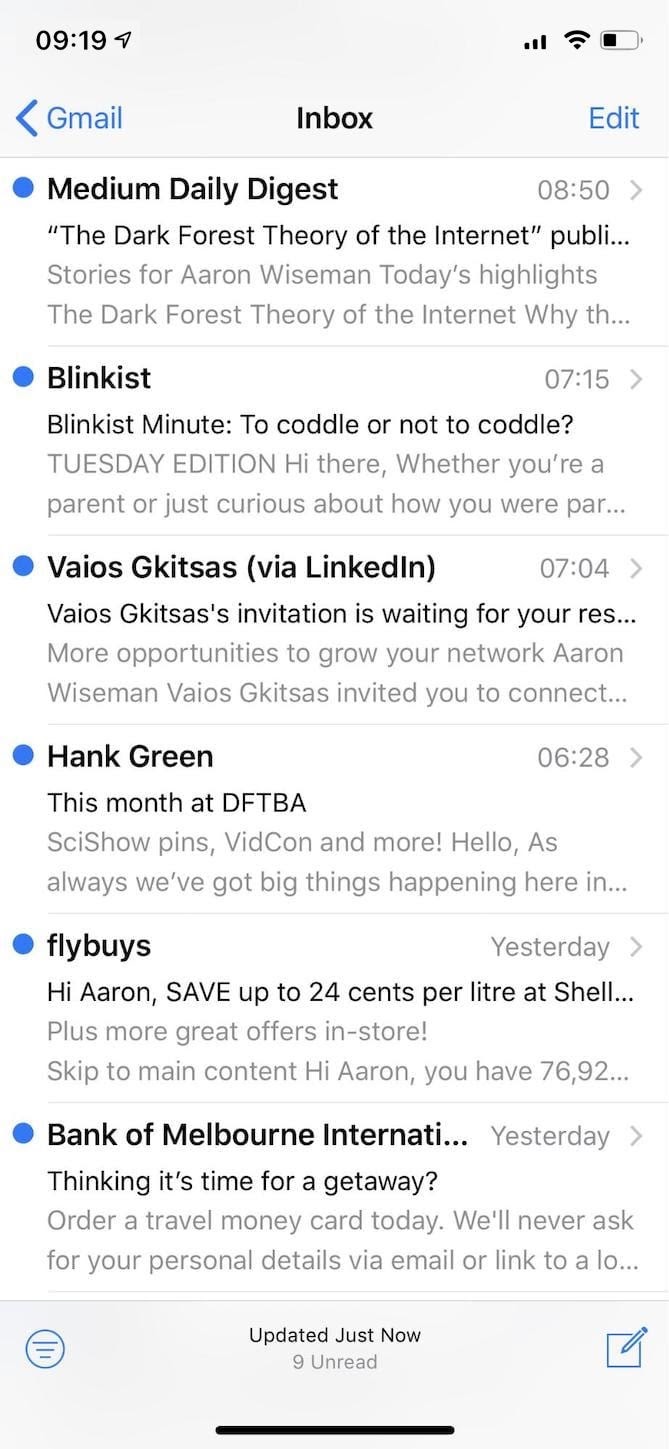Email marketing is great. It lets you reach and communicate directly with your audience wherever they are and whenever you want.
Not only does everyone have an email address, but unlike with social media, there are no algorithms you have to play nice with that control your reach.
Email has also been around longer than the internet itself and despite people claiming that it’s either dying or ready dead, it remains the most profitable digital marketing channel there is.
And while when most people think of emails they think of the copy and design of the email itself, there is one intrinsic part of every email that arguably just as important (if not more so) as the rest of the email combined: Its subject line.
Regardless of why you’re sending emails, whether it’s to sell a product or get people to read your latest blog post, the success of your campaign is highly dependent on your subject line.
So to help improve the effectiveness of your future emails, this post is going to take you through five tips you should keep in mind when coming up with subject lines.
Scale insightful marketing content across the web.
We help you grow through expertise, strategy, and the best content on the web.
The importance of subject lines
First things first: Why and exactly how important are subject lines?
When people open their inbox they’re presented with nothing but a long list of subject lines and sender names. In this sea of emails, your subject line is one of the very few tools you have to grab people’s attention and entice them to open your email.
In a very real sense, subject lines are like book covers, and though people are told not to judge a book by its cover, when it comes to emails many do.
In fact, on average a third of people base their decision on whether to open an email or not entirely on its subject line. When it comes to marking emails as spam, two-thirds do this based solely on subject lines too.
So it doesn’t matter how great your campaign is, if your subject line is sub-par it’ll only ever achieve average results at best.
Luckily there have been plenty of studies on what goes into a great subject line. All of which has been condensed to five key tips below that you can easily implement.
Tip 1) Keep it short
Research has consistently shown that shorter subject lines outperform longer variants.
In one of the best examples of these studies, Litmus found that subject lines with between 4 and 15 characters receive the best open rates. While those with over 50 characters performed the worst.
So the first thing to keep in mind when creating your subject line is to keep them short. If you want to add more details, you can instead use the preview text which most inboxes will also display.
Exactly why people prefer shorter subject lines remains an open question. Perhaps people are simply drawn to shorter ones as they’re quicker and easier to read.
However, the rise in people checking their email on phones might also offer a potential explanation.
Character limits
Unlike Twitter, there’s no hard character limit with your subject lines. While it’s definitely not recommended, you could in theory have your subject lines longer than the email itself.
That said, inboxes will start cutting off your subject line if it’s too long.
While this isn’t usually an issue on desktops, because of the much smaller screens, email apps on phones tend to cut subject lines off relatively early.
As you can see below, the iPhone’s Mail app (one of the world’s most popular inboxes) typically cuts subject lines off around the 45 character mark.

While the exact number of characters you’ll be able to get in varies from device to device, this provides another reason why you should keep your subject lines short. Especially with more people reading email on phones than desktops.
Tip 2) Keep it clear
Even though we may be talking about subject lines as a tool to improve your open rate, it’s important not to forget what they’re there for: To let people know what your email is about.
We know that more descriptive subject lines that better reflect the contents of the email get clicked on more frequently.
Don’t deliberately try to make your subject lines vague in the hope of getting people opening your emails just to find out what’s going on. Chances are they’ll just ignore your email instead.
Even more importantly, don’t make your subject lines misleading either.
While misleading subject lines may indeed improve your open rate, they also lead to higher unsubscribe rates, lower click-through rates, and more people reporting your email as spam. All of which will dramatically harm the effectiveness of your email and all future campaigns. Not to mention it’s also against regulations including CAN-SPAM.
Tip 3) Personalize wherever possible
Personalization is key in digital marketing and your emails are no exception.
We know that personalized emails result in a more than 50% increase in customer satisfaction and achieve better engagement. And the best way to show subscribers that your email is personalized is to personalize its subject line.
This could take several forms.
The easiest and most obvious way is to simply include your subscriber’s name. For example “Hey [NAME], check out our…”. However, if you’re also personalizing the content of your email, you can take this a step further.
Let’s say, for example, you’re a content marketer who’s sending an email based on what type of blog posts your subscriber has read. In this case you could have a subject line along the lines of “Interested in … , [NAME]? Check out…”.
It’s short and personalized and will be much more effective than a “We’ve just published a new blog post” type of subject line.
Tip 4) Make it stand out
Personalization isn’t the only way of making your subject lines stand out in people’s inboxes. There are a couple of other things you can do as well.
One is to play around with your sender name which is simply the name of who sent the email people see in their inboxes.
While this is technically not part of your subject line per se, having a sender name that stands out will get more people reading your subject line and your email opened.
Most brands will simply have their sender name set as their brand name. For instance, “Apple” which is the standard approach.
Unfortunately, some never even set a sender name meaning all that appears is their email domain instead. This is considerably worse when the address is a “noreply” one which only makes your email look incredibly boring.
On the other hand, some brands are now experimenting with adding someone’s actual name to their sender name. Such as “Ben from Flippa” in the screenshot below.

Not only does this make the email seem more personal, but there’s just something about thinking that someone personally sent you an email that draws your attention straight to it.
Consider adding an emoji
Another way to make your subject lines stand out that we’ve likely already seen plenty of brands doing is adding an emoji or two.
What’s going on here is fairly straightforward. Emojis are little bright, colorful images that are obviously going to stand out among regular text.
Just take a look at the inbox below and see which two subject lines stand out the most.

While emojis are not going to work for every brand or in every situation (they work better for B2C brands than B2B for instance), they are something you should consider including.
If you do decide to use an emoji, make sure you follow the best practices for using emojis in subject lines and keep it to a maximum of two. If you include too many, or use irrelevant ones, you’ll only come across as obnoxious and annoy your email subscribers.
Tip 5) Make it engaging
It’s one thing to make your email stand out, it’s another thing to entice people to click on it and read your email.
To increase your chances that people will actually open your email you’ll also want to make your subject line as engaging as possible.
Unfortunately, this is easier said than done. That said, there are a few things you can do to increase your open rates.
Phrase your subject line as a question
Posing a question in your subject line can help pique people’s interest as they will be interested in finding out what the answer is.
For example, if you’re sending an email out about your new blog post on the most common content marketing mistakes, instead of going with the standard “New Blog Post: Top Mistakes Content Marketers Make”, you could go with “Are you making any of these content marketing mistakes?”.
The subject line still concisely conveys what the email is about while being much more engaging.
Turn it into a CTA
Many email marketers will recommend adding a CTA (call to action) to your subject line to increase your email open rates.
So for example, instead of “Up to 50% Off – Today Only”, you go with something like “Shop Now: Up to 50% Off Today Only”. And while that may make the subject line more engaging, you can take things a step further.
Instead of simply adding a CTA, you can in effect turn your entire subject line into a CTA with action-oriented verbs. This works especially well if you start off with an action verb.
For example, compare “Upcoming Webinar Featuring Neil Patel” with “Watch Neil Patel Live in our Upcoming Webinar”.
The first subject line is written matter-of-factly and is not that engaging. By simply starting off with an action verb, the second one is much more engaging and effectively turns it into a CTA.
Conclusion
Regardless of why you’re sending emails, when your subject line in no small way determines the success of your campaign it should be more than just an afterthought.
Especially when writing good subject lines is fairly straightforward.
By keeping the above tips in mind, your subject line will help your email stand out in people’s inboxes and get more people reading its contents.
So before you hit send on your next email campaign, make sure you’ve given it the subject line it deserves.



